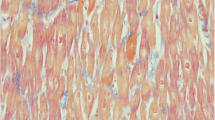Summary
Tyrosinaemia type I (TTI) is an inherited multisystemic disorder of tyrosine metabolism. In addition to hepatic and renal involvement, cardiomyopathy is an important clinical manifestation. Objective: To evaluate the incidence and outcome of cardiomyopathy in TTI. Subjects and methods: A retrospective study was performed of 20 consecutive children with TTI (12 male, 8 female) referred to a single centre between 1986 and 2002. All were initially treated with standard dietary therapy and, since 1992, with nitisinone. The indications for orthotopic liver transplantation (LT) changed during the study. Serial echocardiography was undertaken in all subjects. Results: 9/20 (45%) children had an acute hepatic presentation. Five (25%) received dietary treatment followed by LT, and 14 (70%) were treated with nitisinone at presentation. 6/20 (30%) had cardiomyopathy at initial assessment, with interventricular septal hypertrophy being the commonest finding (5/6). Cardiomyopathy was significantly less common in those treated initially with nitisinone. After a median follow-up of 3.6 (0.45–13.5) years, 5/6 (83%) had complete resolution of cardiomyopathy and 1/6 showed significant improvement. No child with a normal initial echocardiography subsequently developed cardiomyopathy. Conclusion: Cardiomyopathy is a common manifestation of TTI and it has a favourable long-term outcome. Children initially treated with nitisinone are less likely to develop this complication.
Similar content being viewed by others
References
Anan R, Nakagawa M, Miyata M, et al (1995) Cardiac involvement in mitochondrial diseases. A study on 17 patients with documented mitochondrial DNA defects. Circulation 91: 955–961.
Andre N, Roquelaure B, Jubin V, Ovaert C (2005) Successful treatment of severe cardiomyopathy with NTBC in a child with tyrosinaemia type I. J Inherit Metab Dis 28: 103–106.
Berger R, van Faassen H, Taanman JW, De Vries H, Agsteribbe E (1987) Type I tyrosinemia: lack of immunologically detectable fumarylacetoacetase enzyme protein in tissues and cell extracts. Pediatr Res 22: 394–398.
Berko BA, Swift M (1987) X-linked dilated cardiomyopathy. N Engl J Med 316: 1186–1191.
Briggs DW, Condie LW, Sedman RM, Tephly TR (1976) δ-Aminolevulinic acid synthetase in the heart. J Biol Chem 251: 4996–5001.
Edwards MA, Green A, Colli A, Rylance G (1987) Tyrosinaemia type I and hypertrophic obstructive cardiomyopathy. Lancet 1: 1437–1438.
Forget S, Patriquin HB, Dubois J, et al (1999) The kidney in children with tyrosinemia: sonographic, CT and biochemical findings. Pediatr Radiol 29: 104–108.
Franz WM, Muller OJ, Katus HA (2001) Cardiomyopathies: from genetics to the prospect of treatment. Lancet 358: 1627–1637.
Graber HL, Unverferth DV, Baker PB, Ryan JM, Baba N, Wooley CF (1986) Evolution of a hereditary cardiac conduction and muscle disorder: a study involving a family with six generations affected. Circulation 74: 21–35.
Gross DM, Williams JC, Caprioli C, Dominguez B, Howell RR (1988) Echocardiographic abnormalities in the mucopolysaccharide storage diseases. Am J Cardiol 61: 170–176.
Heath SK, Gray RG, McKiernan P, Au KM, Walker E, Green A (2002) Mutation screening for tyrosinaemia type I. J Inherit Metab Dis 25: 523–524.
Herman MA, Webber J, Fromm D, Kessel D (1998) Hemodynamic effects of 5-aminolevulinic acid in humans. J Photochem Photobiol B 43: 61–65.
Holme E, Lindstedt S (1998) Tyrosinaemia type I and NTBC (2-(2-nitro-4-trifluoromethylbenzoyl)-1,3-cyclohexanedione). J Inherit Metab Dis 21: 507–517.
Holme E, Lindstedt S (2000) Nontransplant treatment of tyrosinemia. Clin Liver Dis 4: 805–814.
Jain D (2005) Cardiovascular involvement in patients with liver cirrhosis. J Hepatol 42: 3–4.
Kappas A, Sassa S, Galbraith RA, Nordmann Y (1995) The porphyrias. In: Scriver CR, Beaudet AL, Slyws, Valled, eds. The Metabolic and Molecular Basics of Inherited Disease, 7th edn. New York: McGraw-Hill, 1305–1322.
Kordac V, Kozakova M, Martasek P (1989) Changes of myocardial functions in acute hepatic porphyrias. Role of heme arginate administration. Ann Med 21: 273–276.
Lindblad B, Lindstedt S, Steen G (1977) On the enzymic defects in hereditary tyrosinemia. Proc Natl Acad Sci USA 74: 4641–4645.
Lindblad B, Fallstrom SP, Hoyer S, Nordborg C, Solymar L, Velander H (1987) Cardiomyopathy in fumarylacetoacetase deficiency (hereditary tyrosinaemia): a new feature of the disease. J Inherit.Metab Dis 10: 319–322.
Lindstedt S, Holme E, Lock EA, Hjalmarson O, Strandvik B (1992) Treatment of hereditary tyrosinaemia type I by inhibition of 4-hydroxyphenylpyruvate dioxygenase. Lancet 340: 813–817.
Mestroni L, Miani D, Di Lenarda A, et al (1990) Clinical and pathologic study of familial dilated cardiomyopathy. Am J Cardiol 65: 1449–1453.
Miller CG, Alleyne GA, Brooks SE (1972) Gross cardiac involvement in glycogen storage disease type 3. Br Heart J 34: 862–864.
Mohan N, McKiernan P, Preece MA, et al (1999) Indications and outcome of liver transplantation in tyrosinaemia type 1. Eur J Pediatr 158 (Supplement 2): S49–S54.
Moller S, Henriksen JH (2002) Cirrhotic cardiomyopathy: a pathophysiological review of circulatory dysfunction in liver disease. Heart 87: 9–15.
Poudrier J, Lettre F, Scriver CR, Larochelle J, Tanguay RM (1998) Different clinical forms of hereditary tyrosinemia (type I) in patients with identical genotypes. Mol Genet Metab 64: 119–125.
Richardson P, McKenna W, Bristow M, et al (1996) Report of the 1995 World Health Organization/International Society and Federation of Cardiology Task Force on the Definition and Classification of cardiomyopathies. Circulation 93: 841–842.
Russo PA, Mitchell GA, Tanguay RM (2001) Tyrosinemia: a review. Pediatr.Dev.Pathol. 4: 212–221.
Sedman R, Ingall G, Rios G, Tephly TR (1982) Heme biosynthesis in the heart. Biochem Pharmacol 31: 761–766.
Torregrosa M, Aguade S, Dos L, et al (2005) Cardiac alterations in cirrhosis: reversibility after liver transplantation. J Hepatol 42: 68–74.
van Spronsen FJ, Thomasse Y, Smit GP, et al (1994) Hereditary tyrosinemia type I: a new clinical classification with difference in prognosis on dietary treatment. Hepatology 20: 1187–1191.
Weinberg AG, Mize CE, Worthen HG (1976) The occurrence of hepatoma in the chronic form of hereditary tyrosinemia. J Pediatr 88: 434–438.
Author information
Authors and Affiliations
Corresponding author
Additional information
Communicating editor: Georg Hoffmann
Competing interests: None declared
Rights and permissions
About this article
Cite this article
Arora, N., Stumper, O., Wright, J. et al. Cardiomyopathy in tyrosinaemia type I is common but usually benign. J Inherit Metab Dis 29, 54–57 (2006). https://doi.org/10.1007/s10545-006-0203-5
Received:
Accepted:
Issue Date:
DOI: https://doi.org/10.1007/s10545-006-0203-5




